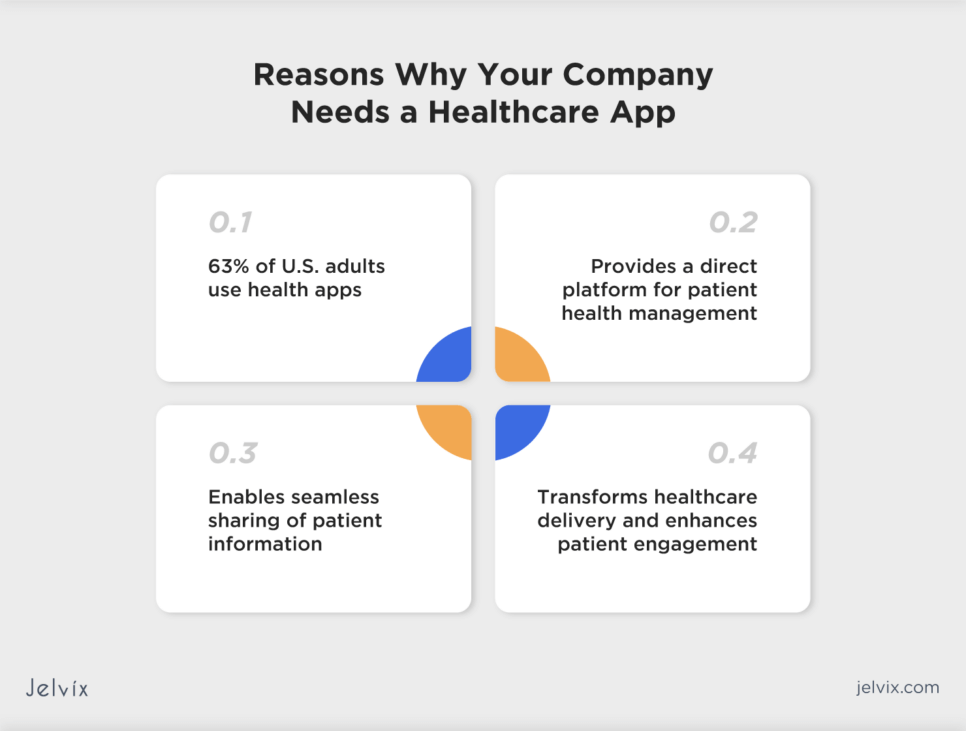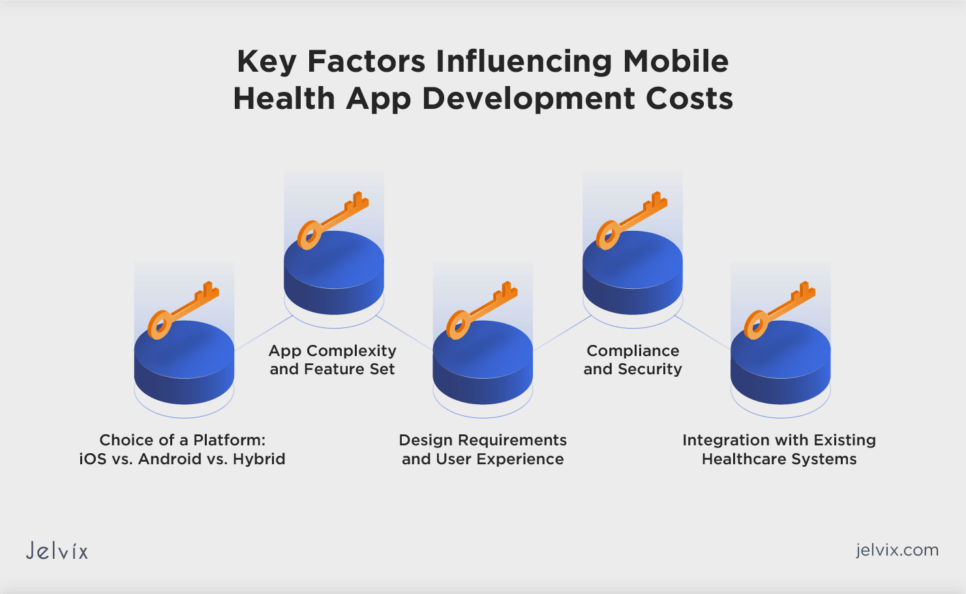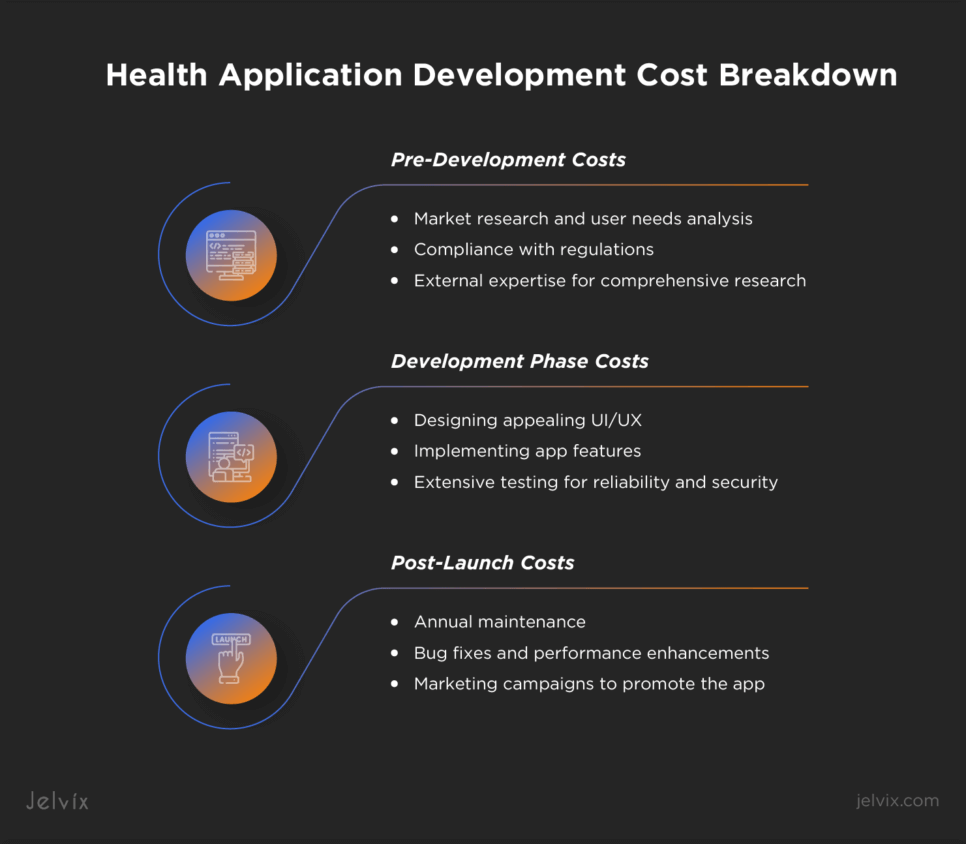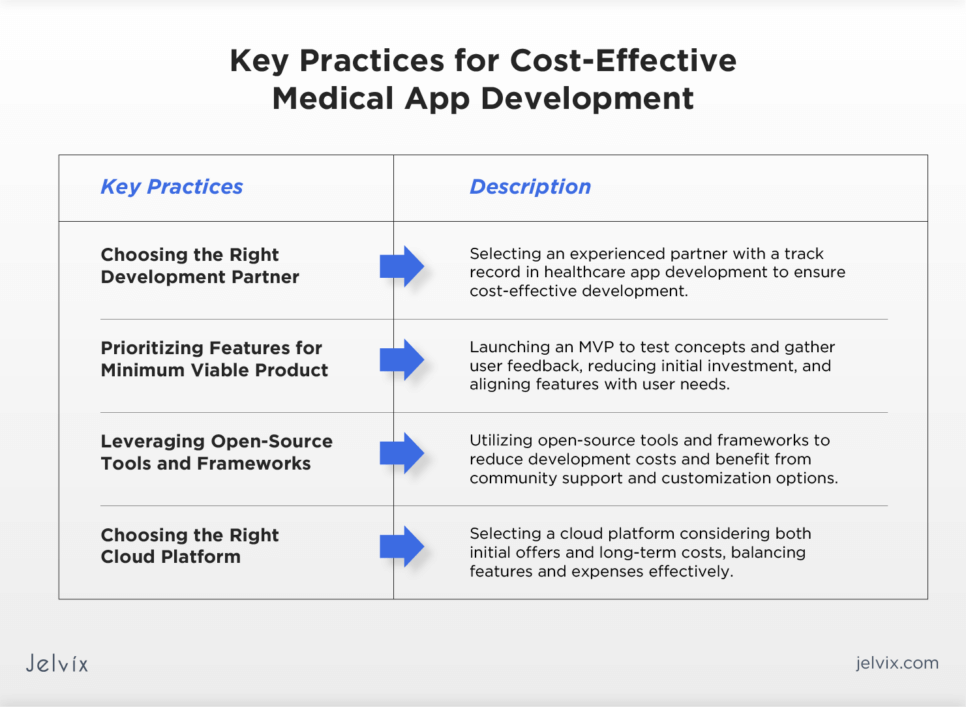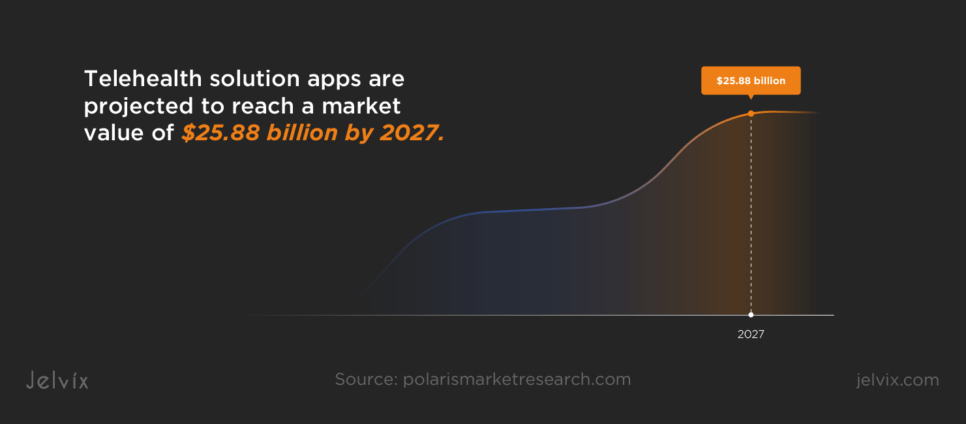The integration of medical apps into healthcare environments is becoming a standard procedure. More companies are implementing mHealth solutions, pushing the market to reach $105.9 billion by 2030.
Although the development of medical apps can be a complex task for healthcare enterprises, it doesn’t necessarily involve huge expenses. A well-planned development process can significantly reduce a medical app’s costs and its market delivery time.
If you aim to make well-informed financial decisions while developing a medical app, keep reading. You’ll learn about the factors that affect development costs, strategies for price optimization, and critical steps in the medical app development process to follow.
The Structure of the Medical App Development Costs
Developing a medical app involves various costs that can vary depending on the app’s complexity, features, and regulatory requirements. Understanding the structure of these costs is crucial for budgeting and financial planning.
Research and Planning
This initial phase of app development involves market research, identifying user needs, and planning the app’s architecture. Costs include hiring experts for market analysis and consulting with healthcare professionals to ensure the app meets user needs.
Regulatory Compliance
Compliance with regulations involves legal fees, compliance audits, and the implementation of security measures to protect patient data.
UI/UX Design
Designing a user-friendly interface and experience ensures ease of use by doctors and patients. Costs cover the design team’s efforts to create intuitive navigation, accessible features, and compliance with accessibility standards.
Software Development
This is typically the most significant cost component where costs vary based on the app’s complexity, the technology stack used, and the development team’s location and expertise.
Quality Assurance and Testing
This component involves costs for QA staff, testing tools, and processes to identify and fix bugs, perform security audits, and ensure the app meets all set requirements.
Deployment and Launch
These are costs associated with deploying the app on platforms like the App Store or Google Play, marketing activities to promote the app, and initial user support and training materials.
Maintenance and Updates
After launch, ongoing maintenance costs include hosting fees, monitoring tools, updates to keep the app compliant with new regulations or operating system updates, and adding new features based on user feedback.
Reasons Why Your Company Needs a Healthcare App
More than 63% of adults in the U.S. use health apps. Pursuing the need to comply with market demands, healthcare organizations seek to develop mobile apps that are functional and easy to use.
A well-developed app can provide a direct and accessible platform for patients to manage their health, access medical records, schedule appointments, and communicate with physicians. It facilitates the seamless sharing of patient information among healthcare systems, supporting coordinated care efforts.
Healthcare apps have the power to transform how medical companies deliver care, engage with patients, and operate on a day-to-day basis, positioning them as forward-thinking leaders in the digital health environment.
Key Factors Influencing Mobile Health App Development Costs
Before venturing into the development of a healthcare app, companies need to understand what factors influence the associated costs. Balancing these considerations with the app’s goals will guide clinics in making informed decisions that align with their strategic objectives and budget constraints.
App Complexity and Feature Set
Basic apps with essential functionalities like appointment scheduling are less expensive compared to those with advanced features such as telemedicine, AI, or integration with wearable devices.
Choice of a Platform: iOS vs. Android vs. Hybrid
Developing a native app for iOS or Android can streamline the process and increase performance, but may be costly. On the other hand, hybrid development is more cost-efficient but may not provide the same high level of user experience as native solutions.
Design Requirements and User Experience
A well-designed app requires a user-centric approach that involves research, wireframing, prototyping, and user testing—all of which are resource-intensive stages. The complexity of the design, including custom graphics, animations, UI/UX prototyping and its rework, and the need for an intuitive, easy-to-navigate interface, directly impacts the amount of time and expertise needed, increasing costs.
Compliance and Security
When developing a healthcare app, ensuring compliance with regulations such as the Health Insurance Portability and Accountability Act in the U.S., or similar standards globally, is a must. Maintaining compliance introduces additional costs, including secure data encryption, secure messaging features, and regular security audits. What’s more, apps must be regularly updated to remain compliant with evolving regulations, requiring continuous investment.
Integration with Existing Healthcare Systems
Integrating EHR systems with healthcare apps is required for seamless data flow and instant access to it. Successful integration enhances the app’s value to healthcare pros and patients, contributing to better health outcomes and operational efficiency.
Learn how effective EHR implementation can streamline healthcare workflows, enhance patient care, and ensure secure data handling.
Integrating Apps with Other Systems: Challenges and Financial Implications
Integration of a medical app with other systems and third-party services presents several challenges and financial considerations that arise from the need to ensure seamless interoperability, maintain data security, and comply with healthcare regulations.
Interoperability Challenges
Integrating disparate systems requires overcoming interoperability hurdles due to varying data standards, formats, and protocols across different EHR systems and healthcare applications. Developing custom interfaces or using middleware to bridge these gaps involves additional costs.
Compliance and Security Costs
Ensuring that integrated systems comply with regulations like HIPAA and GDPR requires rigorous security measures. Implementing and maintaining these standards involves investment in technology and expertise, along with the costs associated with regular compliance audits.
Technical Complexity and Expertise
The technical complexity of integration demands specialized knowledge and skills. Hiring IT professionals with expertise in medical enterprise application development, data security, and regulatory compliance can be costly.
Scalability and Maintenance
As healthcare organizations grow, integrated systems must be scalable and flexible to accommodate new functionalities and increasing data volumes. Conducting regular updates and maintenance to keep up with technological advancements and regulatory changes requires ongoing financial investment.
Testing and Quality Assurance
Careful testing is essential to ensure the integrated app functions correctly and securely. The costs associated with testing and quality assurance can be significant but are crucial for preventing costly errors and data breaches in the future.
Training and Support
Implementing integrated systems often requires extensive training for healthcare staff to effectively use new functionalities. Developing training materials and conducting training sessions add to the overall app development costs.
Health Application Development Process and Cost Breakdown
Developing a healthcare app is a complex process that involves costs at various stages, from initial research to post-launch maintenance. To balance these costs while ensuring the app continues to meet user needs, Jelvix offers customized software development solutions that help drive revenue growth. At the same time, our team ensures safety by providing proactive risk management to mitigate potential security threats.
Pre-Development Costs: Research and Planning
The initial stage of developing a healthcare app involves research and planning activities that lay the foundation for a successful project. These pre-development efforts ensure that the app meets market needs, complies with regulations, and is designed with the end-user in mind.
Note that comprehensive market research requires time and external expertise to analyze the healthcare app market, user needs, and competitor offerings. Costs can escalate with the depth of research, including surveys, focus groups, and data analysis.
Development Phase: Coding, Design, and Testing
The software development phase impacts the overall cost of creating a healthcare app. It usually includes multiple stages, starting from discovery and business analysis and up to testing and product delivery.
Coding, design, and testing are the most budget-consuming stages, each influencing the costs in its own way:
- The design process focuses on creating an appealing user interface and intuitive user experience. Design complexity, from the app’s layout to custom graphic elements, directly impacts development costs;
- During the coding stage, developers implement app features, from patient management to scheduling. Feature complexity affects development time and cost, with advanced functionalities like medical device integration or AI significantly increasing expenses;
- Testing ensures the app’s reliability, security, and usability. This phase involves multiple testing stages and is vital for meeting regulatory and security standards. Extensive testing is necessary but increases development time and costs.
If you want to know the approximate cost of medical app development and read client reviews, you are welcome to check our page on Clutch. However, if you want a detailed quote for your project, we recommend that you fill out a contact form on our site. Jelvix team will contact you shortly to estimate the cost of your project.
At Jelvix, we use state-of-the-art tools and frameworks to optimize software development costs. Depending on the needed functionality, we choose relevant front-end, back-end, mobile, and cloud solutions to suit the unique needs of each project. Our software development process involves careful consideration of your budget constraints and operational needs.
Discover how we developed an RPM solution that enhances patient care through real-time data monitoring.
Post-Launch Costs: Maintenance, Updates, and Marketing
Post-launch costs for a healthcare app involve maintenance, updates, and marketing, each contributing to the app’s ongoing expenses and overall success.
Maintenance typically ranges from 10% to 20% of the original development cost. For an app developed at $100,000, annual maintenance can be $10,000 – $20,000. This covers bug fixes, performance enhancements, and ensuring the app remains compatible with operating system updates.
Launching marketing campaigns to promote the app will involve additional costs that vary depending if you work with individual marketers or a marketing agency.
Estimating Medical Application Development Budget
Estimating the development budget for a medical application requires a thorough understanding of the project’s scope, complexity, and the specific requirements of the healthcare entity. An accurate estimation ensures that the project stays on track financially and meets the set objectives without unexpected spending.
Steps To Estimate the App Development Costs
Accurately estimating the development costs of a medical application involves a detailed analysis of key factors that impact the project’s financial requirements. The Jelvix team recommends that you follow a step-by-step approach for successful budget planning.
1. Define the Project Scope
Clearly outline what the application will do, its key features, and functionalities. Understanding the full scope helps ensure all costs are accounted for from the start till the final phase.
2. Create a Work Breakdown Structure
Creating a WBS will help break down the project into smaller components. This step involves outlining each task required to develop an app, from initial research and design to coding, testing, and deployment. By itemizing tasks, you can assign estimated costs more accurately, providing a clearer picture of the overall financial requirements.
3. Decide on the Development Approach
Determine whether the app will be developed for iOS, Android, or both, and decide between native and cross-platform development. Each choice has different cost implications due to the varying development and maintenance requirements.
4. Estimate the Design Costs
A significant part of the budget will go into designing a user-friendly interface. Custom design and user experience require more resources, increasing the costs.
5. Calculate Development and Testing
Based on the app’s complexity and the chosen technology stack, estimate the man-hours needed for development and testing. Remember to include costs for various types of testing.
6. Include Post-Launch Expenses
Maintenance, updates, and user support are ongoing costs that must be considered. These ensure the app remains functional, secure, and up-to-date with the latest technology and standards.
7. Assess Marketing and Distribution Costs
Determine the budget for marketing the app to reach your target audience effectively. This may include online advertising, promotional materials, and app store optimization.
8. Consider Possible Risks
Identifying potential risks, such as technological challenges, regulatory changes, or delays in the development timeline, allows you to allocate funds for risk mitigation. This proactive approach helps in managing unforeseen expenses and ensures the project remains on track financially.
Tools and Resources for Budget Planning
For effective budget planning in medical app development, consider using tools and resources that facilitate cost analysis, help in tracking expenses, and ensure financial oversight throughout the development process:
- Project management tools help organize and manage software development projects by planning, tracking, and managing tasks, resources, and timelines;
- Financial planning software is good for budget management, offering features for tracking development costs, managing invoices, and forecasting expenses;
- Cost estimation tools are used for creating detailed financial models that account for various cost factors and provide automation features for more accurate cost predictions;
- Online calculators can help get rough cost estimates for financial planning, helping to understand the approximate cost of a project;
- Development communities and forums are where developers and project managers share insights, experiences, and advice on managing app development costs and overcoming financial challenges.
Key Practices to Manage and Reduce App Development Costs
Effective cost management in medical application development ensures projects are completed within the budget and meet quality and compliance standards.
Choosing the Right Development Partner
An experienced partner will help you avoid costly mistakes by offering experience and skilled experts. Select a development partner with a proven track record in healthcare app development, particularly one that understands the regulatory complexities. Review the potential partner’s portfolio for similar projects and request references. Success in relevant projects indicates a likelihood of efficient and cost-effective development for your app.
Prioritizing Features for Minimum Viable Product
Launching an MVP allows you to test your concept in the market without the need for a large initial investment. After the launch, you can use user feedback to guide further development. This approach ensures that additional features are aligned with user needs. For each proposed feature, conduct a cost-benefit analysis to assess its impact on user satisfaction and operational efficiency versus its development cost.
Leveraging Open-Source Tools and Frameworks
Open-source tools and frameworks can significantly reduce development costs by eliminating the need for expensive software licenses. With their help, you can benefit from extensive community support, a wealth of documentation, and code samples that can accelerate development and troubleshooting. What’s more, open-source solutions often provide high levels of customization, allowing developers to tailor the tools to the specific needs of a healthcare app.
Discover practical strategies to lower healthcare chatbot development costs while prioritizing essential features.
Choosing the Right Cloud Platform
When selecting a cloud platform for your healthcare app, it’s essential to consider both initial offers and long-term costs. Major providers like AWS and Google Cloud offer discounts for new customers, which can be attractive at the outset. However, despite such discounts, it’s important to recognize that these platforms are feature-rich and, consequently, tend to be more expensive.
Implementing these strategies can help healthcare organizations manage and reduce the costs associated with developing a medical application. By carefully selecting a development partner, focusing on an MVP, and using open-source technologies, companies can achieve a balance between cost efficiency and delivering a high-quality app to patients.
Case Studies: Cost Analysis of Successful Mobile Healthcare Apps
Considering real-world examples can be beneficial for companies aiming to develop a healthcare app. Although the exact costs of developing mHealth apps depend on their features and complexity, the Jelvix team can provide a brief overview of some apps, including their strengths and potential areas for improvement, and explain how this influences the development costs.
HealthTap
HealthTap is a telehealth app that offers 24/7 access to doctors and an AI-driven symptom checker. Such features demand a robust back-end and compliance with healthcare regulations, which increases development costs. Its user interface and personalization features could be improved for enhanced user engagement, suggesting a trade-off between cost and user satisfaction. The integration of prescription services adds convenience but requires secure data handling, raising costs.
Talkspace
Talkspace stands out for its focus on privacy and a wide range of therapy services, including text, voice, and video consultations. These features require secure communication channels and sophisticated matching algorithms for therapist pairing, both of which are costly. Enhancing interactive features and integrating AI could improve user engagement but would also increase development and operational expenses.
Mindly
Mindly offers a user-friendly design and focuses on privacy and security, crucial for mental health apps. Its self-help tools offer significant value with relatively low development costs. However, integrating functionalities for sharing progress with physicians and enhancing customization through AI could offer better personalization at the expense of higher complexity and costs.
Funding and Investment for Healthcare Application Development
Securing funding and investment is a critical step in turning your healthcare app idea into a reality. Understanding various funding options can make a significant difference in the success of your app development project.
Exploring Funding Options for App Development
Healthcare organizations can choose among various funding options, each having its trade-offs. The choice should depend on their specific circumstances, including the stage of the project, financial needs, and long-term business goals.
Bootstrapping
You can use personal funds or operational revenue to finance the app’s development. This approach gives you full control over the project but may limit growth due to financial constraints.
Venture Capitalists
The VC firms invest in startups with high growth potential, providing funding in exchange for equity. VCs also bring expertise and connections but typically seek significant control and a clear exit strategy.
Crowdfunding
Platforms like Kickstarter or Indiegogo allow you to present your project to the public and raise small amounts of money from a large number of people. This method can also validate your app idea and build a community of early adopters.
Grants and Government Programs
Some government bodies and private organizations offer grants to support innovation in healthcare technology. These funds usually don’t require giving up equity but often have specific eligibility criteria and application processes.
Strategic Partnerships
Partnering with established companies in the healthcare industry can provide funding, resources, and access to customer networks. In exchange, partners may seek equity or exclusive rights to your technology.
The Future of Mobile Healthcare App Development
Artificial intelligence is a growing trend in the healthcare market, with experts predicting it will reach nearly $188 billion by 2030. As a result, more medical apps are expected to become AI-driven, offering advanced predictive health analytics.
Healthcare apps will be integrated more widely with wearables, driven by the increasing numbers of using these devices which will reach $26 bln by 2030.
Finally, telehealth solution apps will deliver help to more patients around the globe, hitting $25.88 billion by 2027.
How Jelvix Can Assist in Medical App Development
Integrating medical apps into healthcare settings brings its own set of challenges and opportunities. At Jelvix, we recognize that the healthcare industry demands innovative solutions that leverage the latest technology and protect patient data, so we make sure our products adhere to HIPAA standards.
Our strategy for developing and implementing medical apps focuses on personalization, compliance, and enhancing patient experiences. If you need help creating a medical app from scratch or upgrading an existing one, contact us for a solution customized to your organization’s unique needs and budget.
Estimate My Project
Ready to develop your healthcare app? Begin with a free estimate.



